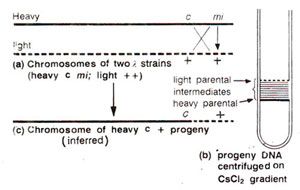Meselson and Weigle's experiment using lambda (λ) phage
The above two strains of λwere used for simultaneous double infection of E. coli cells grown on a medium containing 12C and 14N. After lysis phage particles were analysed by spinning in a caesium chloride density gradient.
A wide band was observed, which indicated that the phage DNA ranged in density from the heavy parental value to the light parental value, with several intermediate densities (Fig. 10.18). Recombinant phages c + were also recovered, which had a density close to heavy parental value. This could be explained because only a small tip of chromosome carrying + allele of mi would come from the light parental chromosome. In the reciprocal cross, when heavy ++ phages were crossed with light c mi, heavy recombinants were + mi and light recombinant phages were c + as expected. These experiments suggested physical breakage and reunion of DNA leading to recombination.





